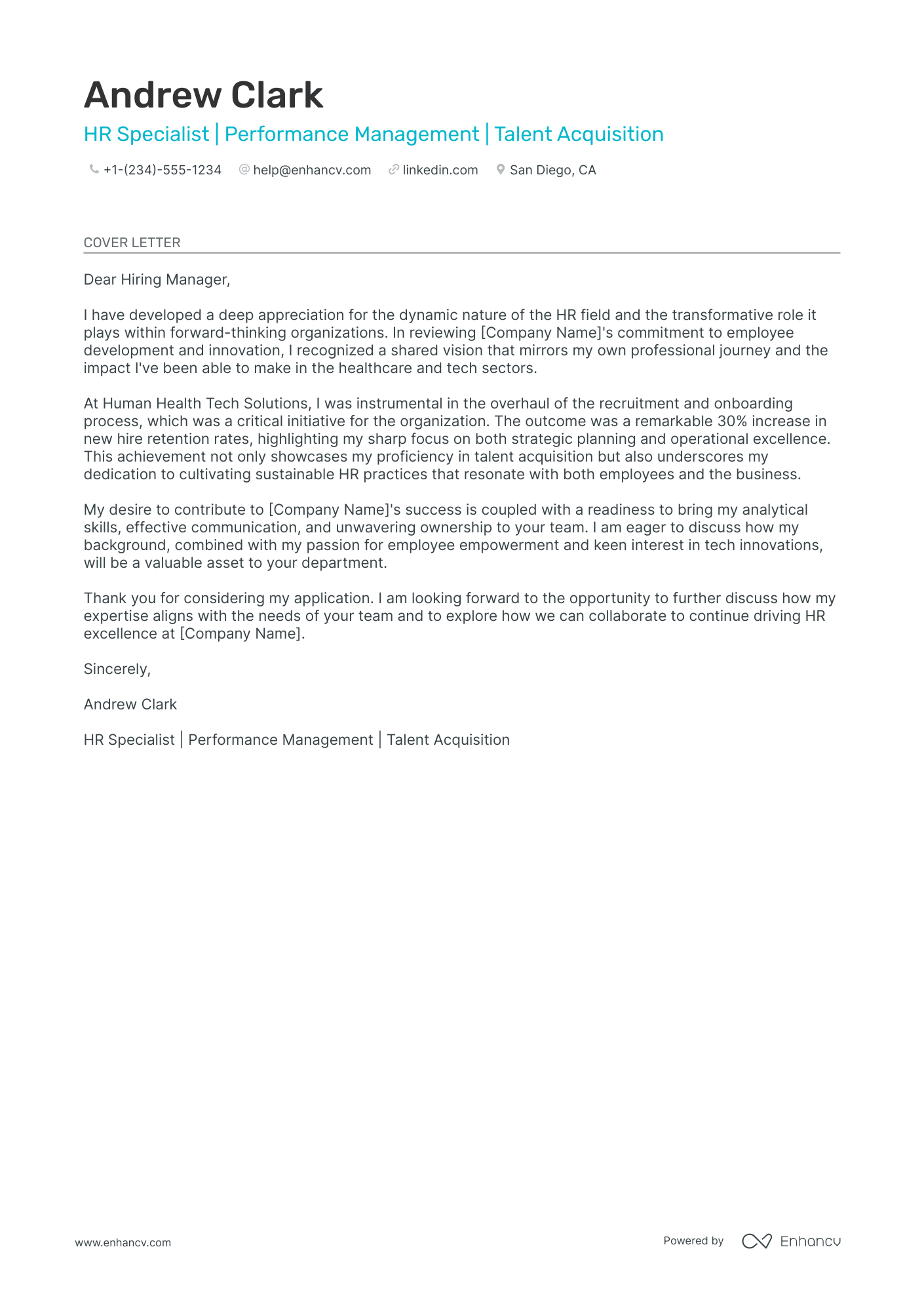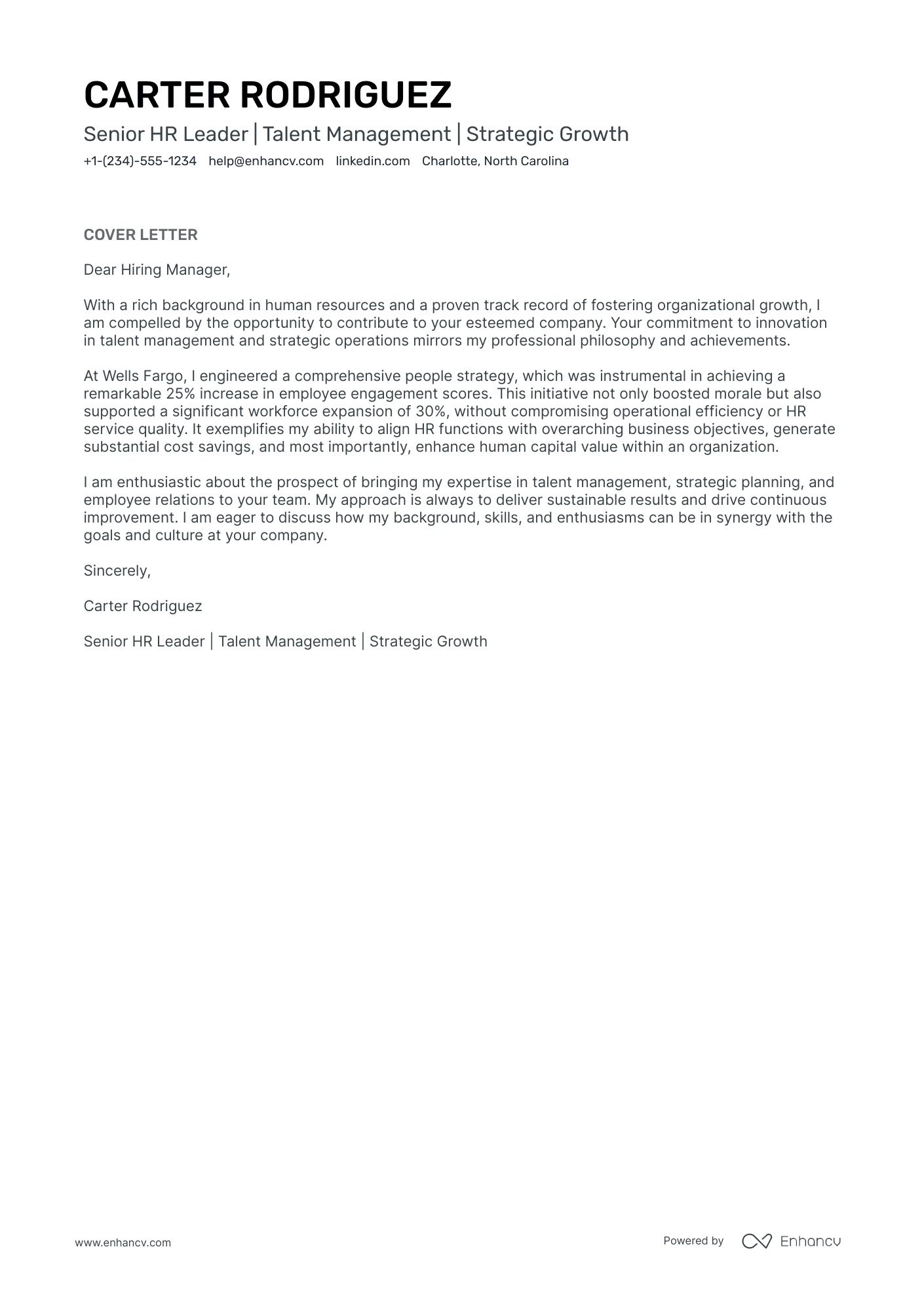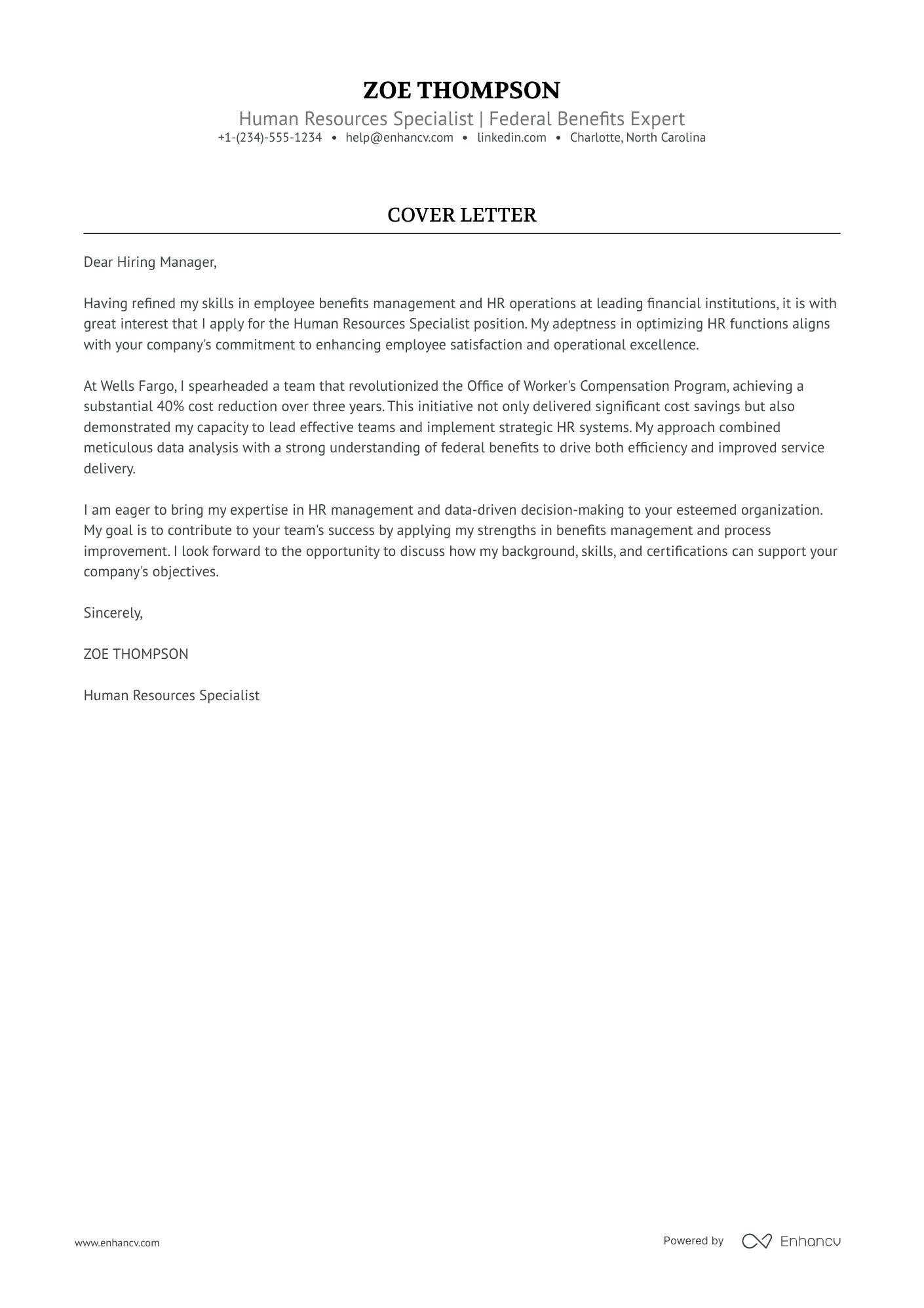Embarking on your job search, you've realized a compelling HR cover letter is a must, yet mastering this pivotal document is no small feat. It’s not about echoing your resume; it's your chance to captivate with a narrative of your proudest professional triumph. Steer clear of the well-trodden clichés and strive for formality with a personal touch, all within the confines of a concise, one-page letter that sets you apart. Let's tackle the art of the cover letter together.
- Personalize your hr cover letter and get inspired by other professionals to tell a compelling story;
- Format and design your hr cover letter to make an excellent first impression;
- Introduce your best achievement in your hr cover letter to recruiters;
- How to make sure recruiters get in touch with you, using your hr cover letter greeting and closing paragraphs.
What is more, did you know that Enhancv's AI can write your cover letter for you? Just upload your hr resume and get ready to forward your job application in a flash.
If the hr isn't exactly the one you're looking for we have a plethora of cover letter examples for jobs like this one:
Drop your resume here or choose a file.
PDF & DOCX only. Max 2MB file size.
HR cover letter example
Charlotte Jones
Fort Worth, Texas
+1-(234)-555-1234
help@enhancv.com
- Highlighting past achievements: The cover letter mentions a successful diversity and inclusion initiative, providing specific results such as a 40% increase in minority representation in leadership, which demonstrates the candidate's ability to implement effective HR strategies.
- Connecting personal values with company values: Referencing the "trailblazing initiatives" at the company shows that the candidate has done their research and is genuinely interested in the company's work, thereby establishing a value alignment between the candidate and potential employer.
- Aligning HR objectives with business goals: The applicant showcases strategic thinking by demonstrating how HR initiatives have previously enhanced operations and set industry benchmarks, implying a strong understanding of how HR supports broader business objectives.
- Expressing a desire for professional growth: The candidate conveys enthusiasm for contributing to the team and continuing to develop their skills, suggesting a forward-looking and growth-oriented mindset.
Structuring and formatting your hr cover letter
Here's what the structure of your hr cover letter should include:
- Header (with your name, the position you're applying for, and the date);
- Salutation (or greeting);
- Introductory paragraph (or your opening statement);
- Body paragraph (or further proof of your experience);
- Closing paragraph (with a call to action);
- Signature (that is optional).
Use the same font for your hr resume and cover letter - modern fonts like Lato and Rubik would help you stand out.
Your hr cover letter should be single-spaced and have a one-inch margins - this format is automatically set up in our cover letter templates and our cover letter builder.
When submitting your cover letter, always ensure it's in PDF, as this format keeps the information intact (and the quality of your document stays the same).
On one final note - the Applicant Tracker System (ATS or the software that is sometimes used to initially assess your application) won't read your hr cover letter.
Maximize your efficiency! With our free cover letter generator, you’ll have a great letter in moments.
The top sections on a hr cover letter
- Header: Include your name, contact information, and the date, as well as the employer's name and address; this provides a professional-looking structure and makes it easy for the recruiter to identify who you are and how to contact you.
- Greeting: Address the recruiter or hiring manager by name if possible; a personalized greeting shows that you've done your research and are serious about the position.
- Opening Paragraph: Start with a strong introduction that captures the recruiter's attention and clearly states the HR position you're applying for; this sets the tone for why you are the right candidate.
- HR-Specific Expertise and Experience: In the body of the cover letter, highlight your relevant HR experience, knowledge of employment laws, and interpersonal skills; this demonstrates your capability to handle HR responsibilities effectively.
- Closing and Call to Action: End your cover letter with a professional closing statement and a call to action, expressing your enthusiasm for the role and inviting the recruiter to discuss your application further; it's a proactive way to encourage a response.
Key qualities recruiters search for in a candidate’s cover letter
- Deep understanding of employment laws and regulations: Essential for ensuring the company's hiring practices are legally compliant.
- Expertise in talent acquisition and recruitment strategies: Key for attracting and retaining the best candidates in a competitive job market.
- Strong interpersonal and communication skills: Necessary to engage effectively with candidates, employees, and management at all levels.
- Experience with HR software and tools: Proficiency in using applicant tracking systems, HR information systems, and performance management platforms streamlines HR processes and improves efficiency.
- Ability to handle sensitive and confidential information: HR professionals deal with personal employee data and must maintain discretion and integrity.
- Conflict resolution and problem-solving skills: Important for mediating disputes, addressing employee concerns, and fostering a harmonious workplace environment.
Greeting recruiters with your hr cover letter salutation
What better way to start your conversation with the hiring manager, than by greeting them?
Take the time to find out who the professional, recruiting for the role, is.
Search on LinkedIn, the company website. And for those still keen on making a fantastic first impression, you could even contact the organization, asking for the recruiter's name and more details about the job.
Address recruiters in the hr greeting by either their first name or last name. (e.g. "Dear Anthony" or "Dear Ms. Smarts").
If you're unable to discover the recruiter's name - don't go for the impersonal "To whom it may concern", but instead use "Dear HR team".
List of salutations you can use
- Dear Hiring Manager,
- Dear [Company Name] Team,
- Dear [Department Name] Team,
- Dear Mr./Ms. [Last Name],
- Dear [Job Title] Hiring Committee,
- Dear [Job Title] Search Committee,
What to include in those first two sentences, or your hr cover letter introduction
Have you ever wondered what the best way is to present your profile in the hr cover letter introduction?
There's no right or wrong answer if you're being concise and authentic to yourself.
Some professionals start their hr cover letter by:
- congratulating the company - focusing on something impressive, whether that's an award, an industry-leading project, or a key event;
- aligning their passion for the field or industry with the job - if you're enthusiastic about what you do, you'd thus grow your skill set and value as a professional.
What comes next: your hr cover letter middle paragraphs
In the next three to six paragraphs (or the body of your hr cover letter) you have to prove your unique value.
Most candidates tend to mess up at this stage. They tend to just copy-paste information from their resume.
That's one big no-no.
Remember that when writing your hr cover letter, it has to be personalized. And, your ultimate aim is to catch the recruiter's eye.
So, look back on key job requirements and write down a list that includes the ones you cover.
Next, select just one key achievement from your professional (or personal) history that meets those advert keywords.
Narrate a story around how you've grown your skill set and knowledge. Also, aim to show the unique understanding or soft skills you bring about, thanks to your past success.
Two ideas on how to end the final paragraph of your hr cover letter
Closing your hr cover letter, you want to leave a memorable impression on recruiters, that you're a responsible professional.
End your cover letter with how you envision your growth, as part of the company. Make realistic promises on what you plan to achieve, potentially, in the next six months to a year.
Before your signature, you could also signal hiring managers that you're available for the next steps. Or, a follow-up call, during which you could further clarify your experience or professional value.
What could you write about in your hr cover letter when you have no experience
Candidates with zero professional experience often struggle to write their hr cover letter.
You may lack experience, but your application could still be impressive when you focus on your strengths.
Consider your most relevant talents (and/or one achievement) that align with the role and help you stand out.
Perhaps you spent every summer volunteering at your local dog pound - think of the job-relevant skills this experience taught you.
Sharing your tangible career goals is another good strategy to stand out.
Key takeaways
Winning at your job application game starts with a clear and concise hr cover letter that:
- Has single-spaced paragraphs, is wrapped in a one-inch margin, and uses the same font as the hr resume;
- Is personalized to the recruiter (using their name in the greeting) and the role (focusing on your one key achievement that answers job requirements);
- Includes an introduction that helps you stand out and show what value you'd bring to the company;
- Substitutes your lack of experience with an outside-of-work success, that has taught you valuable skills;
- Ends with a call for follow-up or hints at how you'd improve the organization, team, or role.
HR cover letter examples
By Experience
Human Resources Intern
Entry-Level Human Resources
Junior Human Resources
< - Main Article
By Role

























